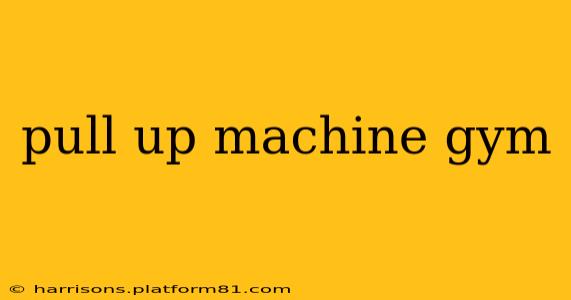The pull-up, a cornerstone of upper body strength training, is a challenging exercise for many. But what if you don't have the strength to do a full pull-up yet? That's where the pull-up machine comes in. This comprehensive guide explores everything you need to know about pull-up machines in the gym, from their various types to how to use them effectively. We'll even tackle some frequently asked questions to ensure you're ready to conquer your fitness goals.
What is a Pull-Up Machine?
A pull-up machine, also known as an assisted pull-up machine or lat pulldown machine (although lat pulldowns are a slightly different exercise), is a piece of gym equipment designed to help users perform pull-ups with varying degrees of assistance. This assistance reduces the amount of bodyweight you need to lift, making the exercise more accessible to beginners and those recovering from injuries. These machines typically utilize a weight stack or a counterbalance system to adjust the level of assistance. This allows you to gradually increase the difficulty as you get stronger, eventually working your way up to unassisted pull-ups.
Types of Pull-Up Machines
Several types of pull-up assist machines are available in most gyms:
- Assisted Pull-Up Machine: This is the most common type. It usually involves a seated position with a padded support to help with your legs and a system to adjust the weight assistance.
- Lat Pulldown Machine: While technically a different exercise, lat pulldowns use a similar pulling motion and can build the strength needed for pull-ups. They involve pulling a weighted bar down towards your chest, working the back and biceps.
- Gravity-Assisted Pull-Up Machine: These machines use a counterbalance system to reduce the weight you need to lift, providing a smooth and controlled assisted pull-up.
How to Use a Pull-Up Machine
The exact method for using a pull-up machine will depend on the specific machine's design, but here's a general guide:
- Adjust the Weight: Begin by setting the machine to provide significant assistance. You should be able to perform several repetitions with good form without excessive strain.
- Grip the Bar: Grab the pull-up bar with an overhand grip, slightly wider than shoulder-width apart. Ensure a firm grip.
- Engage Your Core: Keep your core tight throughout the exercise to maintain proper posture and stability.
- Pull Yourself Up: Pull yourself upwards until your chin is over the bar. Focus on squeezing your shoulder blades together and using your back muscles.
- Controlled Descent: Slowly lower yourself back to the starting position. Avoid dropping down quickly.
- Repeat: Perform the desired number of repetitions.
How Much Weight Should I Use on a Pull-Up Assist Machine?
Start with a significant amount of assistance. It's better to feel like you're lifting a lighter weight and using good form than to struggle with too much resistance and compromise your technique. Gradually reduce the assistance as you get stronger. Aim for a gradual progression where you progressively decrease the assistance weight by small increments.
Can I Use a Pull-Up Machine to Build Muscle?
Absolutely! Even with assistance, pull-ups, whether performed on a machine or not, are a compound exercise that works multiple muscle groups, including your back, biceps, forearms, and shoulders. By consistently using a pull-up machine and progressively reducing assistance, you will effectively build muscle and increase your overall strength, eventually leading to performing unassisted pull-ups.
What Muscles Does the Pull-Up Machine Work?
The primary muscles worked by pull-up machines are the latissimus dorsi (lats), the muscles of the upper back, and the biceps. However, the exercise also engages the forearms, shoulders, and core muscles for stabilization.
What are the benefits of using a pull-up machine?
Pull-up machines offer several key benefits:
- Progressive Overload: Allows you to gradually increase the difficulty as you get stronger.
- Accessibility: Makes pull-ups accessible to beginners and those with limited upper body strength.
- Injury Prevention: Reduces strain on your muscles and joints by providing assistance.
- Improved Strength and Muscle Growth: Effectively builds muscle and increases strength in your back and biceps.
By utilizing a pull-up machine effectively and consistently, you can progress towards achieving your fitness goals and eventually perform unassisted pull-ups. Remember to focus on proper form and gradually increase the difficulty. With dedication and the right technique, you'll be well on your way to mastering this challenging yet rewarding exercise.
